Crawling Back: Amazing Spider-Man #28 Review
This issue deserves recognition for how it handles Peter Parker's personal growth over the blazing bad guy it introduces
—by Nathan on June 12, 2025—
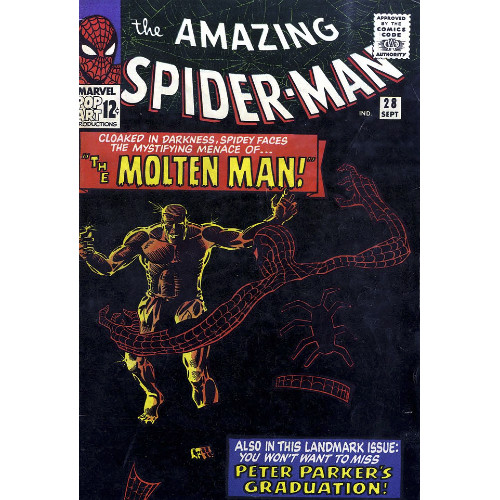
While I wrote my "Osborn Prelude" reviews, I referenced, at intervals, two important members of the extended Osborn family: Liz Allen, wife of Harry Osborn and mother of Normie Osborn, and Mark Raxton, Liz's step-brother. Mark, you'll notice, is the guy with the shiny skin that makes him look like a walking Oscar trophy with hair.
And he doesn't get it from moisturizer.
At a slightly later stage in Amazing Spider-Man history than we're examining today, writer Gerry Conway revealed the connection between Liz and Mark, and ever since then, poor Liz Allen has had her life pinballed between the ongoing feuds her two supervillain relations had with our ever-lovin' Web-Head. But waaaay before those familial conflicts, Liz and Mark popped up in a Stan Lee/Steve Ditko issue, unbeknownst to one another.
As both Liz and Mark have played their roles in my recent "Osborn Prelude" posts, I wanted to step back to this issue where Mark Raxton debuted, where he first fell afoul of his frustrating skin condition. And though this isn't Liz's first appearance on the page, this issue marks a dramatic turning point for both herself and Peter Parker as both teens leave the confines of their beloved high school.
"The Menace of the Molten Man"
Writers: Stan Lee and Steve Ditko (credited as plotter)
Penciler: Steve Ditko
Inker: Steve Ditko
Colorist: Uncredited
Letterer: Sam Rosen
Issue: Amazing Spider-Man #28
Issue Publication Date: September 1965

My earliest memories of this issue don't fill me with exuberant nostalgia–not that I think poorly on this issue, but I don't feel the same way I do when I think of early Spider-Man issues I consider personal favorites, such as that first ASM annual or ASM #39-40. 1965, glancing back, was quite the year for supervillains–not only did Lee and Ditko invent the Scorpion (possibly the most memorable madman of the crop), but readers were also introduced to the Beetle, the Crime-Master, the Circus of Crime, the first Spider-Slayer, and the cat burglar known as…well, the Cat (not all of 'em can be winners, kay?). Maybe no one here ascends to the heights of villainy in the same way earlier creations such as Doc Ock, Sandman, or the Green Goblin have, but these crooks recur often enough to win my support and admiration. Why, if it weren't for the Beetle, we wouldn't have the funniest supporting cast member of Nick Spencer's Superior Foes of Spider-Man!
Ahem.
Molten Man has never climbed the ranks of my personal opinion, but he's been around the block a couple of times, and his connection to Liz makes him a somewhat stronger character. From such humble origins he springs, however, in a tale which actually feels more notable for a scene with Liz rather than the entirety of the Spidey/Moltey tussle we're given here. But more on that later in the review.
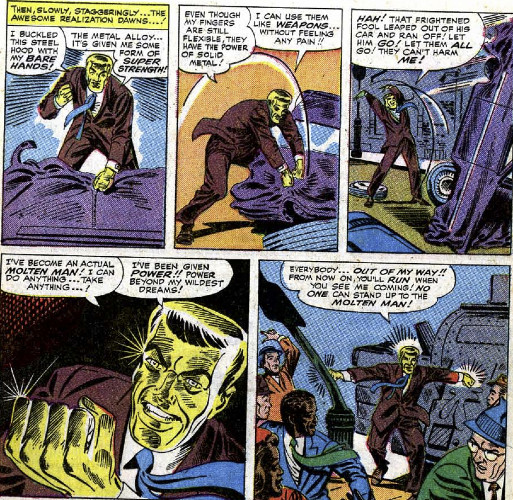
As noted, the Molten Man is Mark Raxton, a one-time lab assistant to Spencer Smythe, the original inventor of the Spider-Slayer. A few issues after that mechanized menace's grand debut, Peter Parker visits the scientist under false intentions, really hoping to pick up the Spider-Man costume he left to fool Jameson during the Slayer fiasco (for the past two issues, Spidey's been duking it out with the Green Goblin and the Crime-Master's men in an uncomfortable outfit he bought at a costume store). While at Smythe's, Peter witnesses the tragic transformation of Raxton into the Molten Man, and as Spidey, takes it upon himself to make sure the man with the molten skin doesn't damage anyone else.
Raxton is a fairly simple character, which may be one reason why this issue has never sunk into my memory. You don't learn much about who he is outside the fact he's Smythe's assistant and that, as soon as he recognizes the strength he's been gifted, he decides to plot "a really big crime," in his words. Most of his time is spent either breaking things or slugging it out with Spidey. Lee and Ditko do hint at him being a selfish sort of fellow, which seems to explain why he harasses Smythe for the liquid metal alloy which eventually bonds to his skin and perhaps why he engages in some roughhousing with a car and thinks his best career opportunity is crime. But other than his fairly prickly attitude, the Molten Man is a bit of a blank slate in terms of character, which makes me all the more grateful for Conway's contributions several years later.
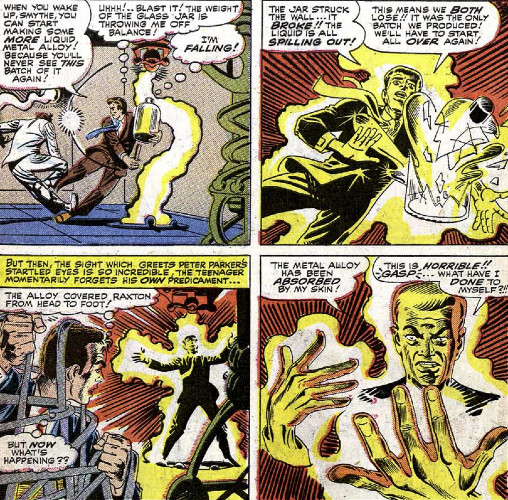
How Mark stands out in this issue is through the kind of tussle he gives Spidey, allowing Ditko to create an extended sequence between the two combatants. As Ditko also plotted the issue, I assume he had a level of control over the fight itself, and if that's the case, it shows in how creative this sequence is. The two battle across several floors of an apartment complex, busting through doors, smashing furniture, tumbling down stairs. Narratively, it's a chance for Lee and Ditko to let Peter use his brain to win this fight–with an opponent seemingly as strong as he is, Spidey has to switch tactics and defeat the Molten Man through wilier means.
From an artistic perspective, I can also see where Ditko had some fun with this fight. After a basement light fixture is busted, Ditko creates several panels without any backgrounds and shades the Molten Man in a way that he appears slightly brighter without any other light source to compete with. I do wish Ditko had replicated for the interior his approach with the cover, blacking out portions of Spidey's costume to provide that sense of all encompassing darkness. It's a very neat effect and would have given a greater sense of Spidey sneaking through the blackness, guided by his spider-sense to trick Raxton.
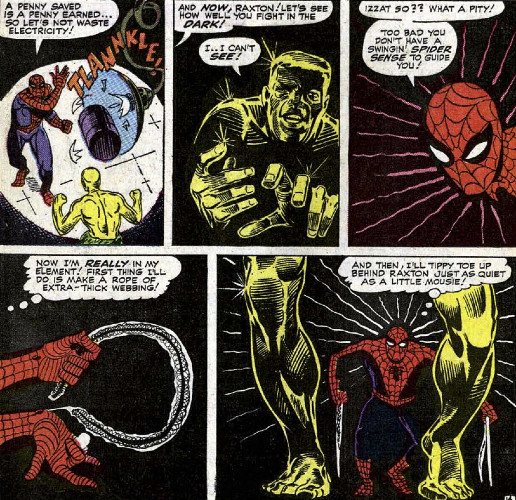
The end of the fight, if I can offer one other complaint, is a little lackluster–after tying Raxton's hands and feet, Spidey just leaves him for the cops. The fight seems to have gone completely out of the Molten Man, and he just sits, waiting to be arrested. I'm not sure if this was a plotting issue or a dialogue problem; Lee's dialogue for Raxton has the Molten Man indicate he's befuddled as to why he's just giving up for the police–one panel, he's fighting Spidey, the next he's sitting, apparently defeated. We don't get the sense he's too tired to keep fighting, that he's officially surrendering…the fight just ends. These panels have always confused me as much as the incident seems to confuse Raxton. There's just no definitive end point to the fight, Raxton switching from belligerent to docile in the span of a single panel.
But maybe Ditko needed a way for the fight to end quickly, as we're then thrown into this issue's other dramatic sequence: Peter Parker's graduation from high school! More so than its central villain, this sequence is why the issue should be remembered. The graduation is an important moment in Peter Parker's growth as a character–so much so that high school graduation scenes are in both the original Spider-Man movie from Sam Raimi and the second Amazing Spider-Man film–and marks a turn towards adulthood for the young man. Already having taken on so much additional responsibility as Spider-Man, Peter has a chance to remind us of the dividends earned by his consistent work ethic as a student as well. Rumor has it that Ditko objected to Peter graduating high school, but these just seem like fluffy conjectures with no real substance to them. I don't imagine Ditko developing this sequence under duress.
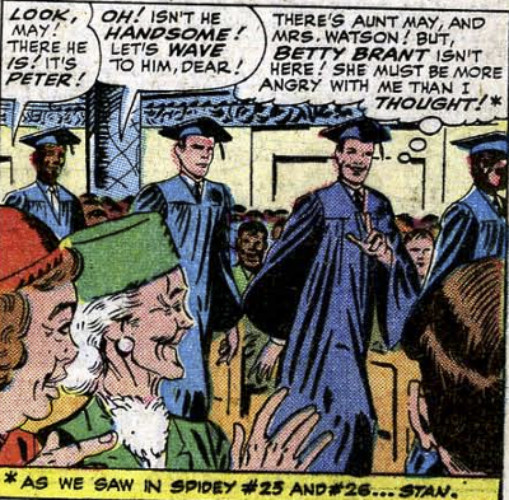
The graduation scene itself is a highlight for several reasons, but I do want to take a moment and note the importance of the moment. Peter Parker graduates high school. If you take the common acknowledgment that Peter was fifteen when he was bitten by the spider as gospel, this means he's been Spider-Man for two-and-a-half to three years in the Marvel Universe, about as long as the character had been around at this point. That's a lot of time to have passed in twenty-eight issues, and the character's chronology will slow down dramatically after this point (to compare: Peter starts college in ASM #31 and doesn't graduate until ASM #185, in 1978–thirteen years real time after graduating high school!). So while Peter would no longer age in "real time," this issue remains a solid representation of the kind of development he deserved. Like a bevy of his readers at the time, Peter was allowed to grow, to move from one important life stage to the next.
I feel, for the last however many years (if not the last few decades), Peter has existed in this nebulous "young adult" stage, where he doesn't really grow or progress forward in any significant or permanent way. Heck, the powers-that-be retconned one of his major developments where they annihilated his marriage! Sure, there are concerns that Peter would otherwise age too quickly, so I get the dramatic slowdown. At the same time, knowing that I am currently as old (if not a year or two older, depending on what you read on the internet) as my favorite pop culture character, who I've been reading since I was nine years old and who's been around for sixty-plus years, is somewhat unnerving. Let the guy age a little! At least let him hit his 30s or mid-30s. Understanding how dramatically Peter's life has been slowed down overall to maintain the illusion of his agelessness, I appreciate seeing a development such as this–an important aspect I feel is missing or subdued in current Spidey comics–way back in the 60s. Peter has trajectory to him, prospects, possibilities.
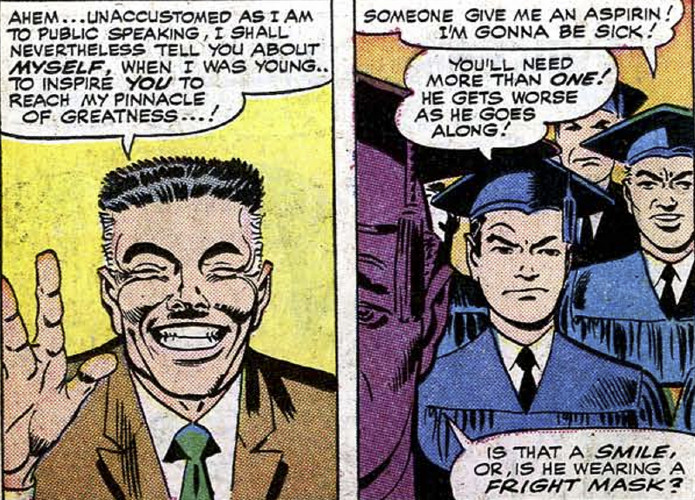
Within the whole sequence are several standout moments, including a "rousing" speech from Daily Bugle publisher J. Jonah Jameson, his grimacing grin on display for all to see, as well as the announcement that Peter will be attending college on a science scholarship. We feel a sense of accomplishment on the Peter Parker side of things, which always seems to play second fiddle to his superhero responsibilities. Some slight conflict is introduced when we learn that Peter will be attending Empire State University alongside Flash Thompson, Lee and Ditko allowing readers to anticipate how their ongoing rivalry might shape itself in future issues.
But I mentioned Liz graduates as well in the introduction, so I finally come around back to her. In a short sequence, four panels total, Peter has the last interaction he will have with her until that Gerry Conway story where Molten Man also returns (save for a brief run-in in ASM #30…y'know, the same issue that introduced readers to the cat burglar known as…the Cat!). Liz admits to Peter she's always liked him, even if he just had eyes for Betty Brant, but that she's ready to move on. It's a surprisingly adult turn for the character that Lee and Ditko introduce here and remains the one sequence I have consistently remembered from the issue, when it came to my memory at all.
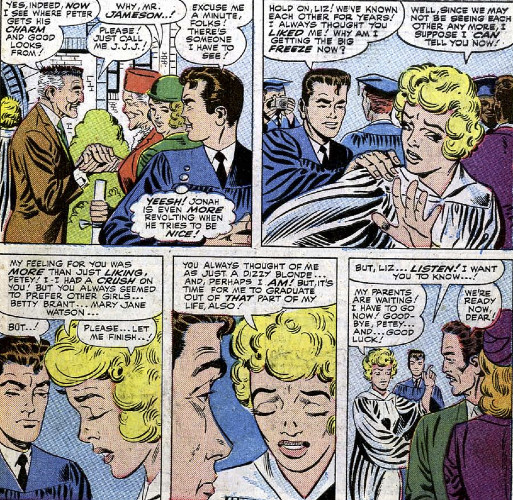
Liz's interest in Peter never seemed that strong to me in the preceding issues, but if you look, it's there. So Liz's revelation felt to me, originally, more of a twist than it may have been to discerning readers. But her ability to open up to Peter, even at a moment as late as graduation, has always felt like a strong step for the character (even if she concedes she may just be a "dizzy blond"). Peter's reaction, though not cold, is a little more halting than I'd hope it would be, but we are given a sense than Ditko wants Peter to realize the opportunity that has passed him by, maybe experience a tinge of guilt for how he acted around Liz, even if Lee's dialogue doesn't necessarily express that.
Though our main antagonist has "molten" in his name, this issue is a far more solid showing than I originally gave Ditko and Lee credit for. The villain is fine–I think, were it not for Conway's later use of the character, the Molten Man could have easily become more of a forgettable villain. The extended fight sequence is clever, but otherwise, there's not much going for Mark Raxton at this stage. But if you enjoy the fight, you'll find the issue's final third even more enjoyable: Peter Parker, taking a step into young adulthood and embracing the next stage of his life, and Liz Allen, doing something similar, asserting an ending for a situation where the person she hoped saw her…just didn't (c'mon, Pete, it's like you're still using glasses!). So with a final "Good-bye, Petey," Liz Allen walks away…leaving Peter, hopefully, with an opportunity to grow beyond receiving a diploma and a scholarship.